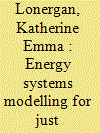|
|
|
Sort Order |
|
|
|
Items / Page
|
|
|
|
|
|
|
| Srl | Item |
| 1 |
ID:
192792


|
|
|
|
|
| Summary/Abstract |
Policymaking increasingly targets an energy transition that is not only low cost and low carbon, but also just. While energy system models have been useful policymaking tools towards achieving the first two objectives, it is yet unclear to what extent they can also support a just transition. Here, we review 73 recent energy systems modelling studies using an analytical coding frame and observe a diversity of approaches to account for energy justice. While models do show promise in being able to support a just transition, especially in terms of assessing distributional outcomes, many of the approaches in the literature are poorly connected to current energy justice goals and discourses, decreasing the studies’ policy relevance and leaving policymakers with suboptimal planning support. Based on our results, we suggest eight actions for modellers to increase the policy relevance of their studies, which include more direct engagement with policy and research discourses, developing location-specific case studies, leveraging public participation in the modelling process, and considering asset decommissioning.
|
|
|
|
|
|
|
|
|
|
|
|
|
|
|
|
| 2 |
ID:
186485


|
|
|
|
|
| Summary/Abstract |
UK power sector decarbonisation is an important step toward achieving the country’s 2050 net zero target. Two uncertainties are particularly relevant to this effort: future electricity demand and biomass availability, the latter due to the potential for negative emissions in the power sector from biomass energy with carbon capture and storage. Using the dynamic simulation model FTT:Power, this work explores the impacts of different power sector policy portfolios on emissions, electricity prices, and government spending under these uncertainties. It finds that deep decarbonisation of the UK power sector is possible, including substantial negative emissions, but that this will require ambitious and diversified policy. Carbon pricing is found to be the single most important decarbonisation policy instrument. Direct regulatory phase-out of unabated fossil fuel power generation is similarly crucial for power sector decarbonisation, and for building resilience to biomass availability uncertainty. That said, under all policy portfolios biomass availability plays a key role in enabling net negative emissions in the power sector. This suggests the importance of securing and improving UK biomass supply, and of decarbonisation outside the power sector to reduce the need for negative emissions to begin with.
|
|
|
|
|
|
|
|
|
|
|
|
|
|
|
|
| 3 |
ID:
110424


|
|
|
|
|
| Publication |
2011.
|
| Summary/Abstract |
The overall objective of this work is to identify the effects of climate change on the Norwegian energy system towards 2050. Changes in the future wind- and hydro-power resource potential, and changes in the heating and cooling demand are analysed to map the effects of climate change. The impact of climate change is evaluated with an energy system model, the MARKAL Norway model, to analyse the future cost optimal energy system. Ten climate experiments, based on five different global models and six emission scenarios, are used to cover the range of possible future climate scenarios and of these three experiments are used for detailed analyses. This study indicate that in Norway, climate change will reduce the heating demand, increase the cooling demand, have a limited impact on the wind power potential, and increase the hydro-power potential. The reduction of heating demand will be significantly higher than the increase of cooling demand, and thus the possible total direct consequence of climate change will be reduced energy system costs and lower electricity production costs. The investments in offshore wind and tidal power will be reduced and electric based vehicles will be profitable earlier.
|
|
|
|
|
|
|
|
|
|
|
|
|
|
|
|
| 4 |
ID:
125859


|
|
|
|
|
| Publication |
2013.
|
| Summary/Abstract |
This paper focuses on Ireland's ambitious target for 2020 to reduce greenhouse gas (GHG) emissions by 20% below 2005 levels for sectors not covered by ETS (Non-ETS). Ireland is an interesting case study due to the role of agriculture (a particularly challenging sector with regard to GHG emissions reduction), that represents 29% of Ireland's GHG emissions compared with less than 10% for the EU. The analysis is carried out with the Irish TIMES model, a bottom-up energy systems modelling tool with detailed characterization of Ireland's energy system. The paper uses scenario analysis to provide pathways that demonstrate how Ireland can meet the non-ETS target at least cost. The paper considers the impacts (in terms of different technology choices and higher marginal abatement costs) arising from higher targets for the energy system to compensate for growth in agriculture activity and low mitigation potential in that sector. The results point to a need to reconsider Ireland's renewable energy focus, with a need for increased effort in renewable transport and renewable heat in particular. The results also point to significant electrification of residential heating. The results also point to a high marginal abatement cost (€213/tCO2), which challenges the analysis carried out at EU level to establish Ireland's non-ETS target.
|
|
|
|
|
|
|
|
|
|
|
|
|
|
|
|
| 5 |
ID:
117317


|
|
|
|
|
| Publication |
2013.
|
| Summary/Abstract |
The Copenhagen Accord established political consensus on the 2 °C limit (in global temperature increase) and for deep cuts in greenhouse gas (GHG) emissions levels to achieve this goal. The European Union has set ambitious GHG targets for the year 2050 (80-95% below 1990 levels), with each Member State developing strategies to contribute to these targets. This paper focuses on mitigation targets for one Member State, Ireland, an interesting case study due to the growth in GHG emissions (24% increase between 1990 and 2005) and the high share of emissions from agriculture (30% of total GHG emissions). We use the Irish TIMES energy systems modelling tool to build a number of scenarios delivering an 80% emissions reduction target by 2050, including accounting for the limited options for agriculture GHG abatement by increasing the emissions reduction target for the energy system. We then compare the scenario results in terms of changes in energy technology, the role of energy efficiency and renewable energy. We also quantify the economic impacts of the mitigation scenarios in terms of marginal CO2 abatement costs and energy system costs. The paper also sheds light on the impacts of short term targets and policies on long term mitigation pathways.
|
|
|
|
|
|
|
|
|
|
|
|
|
|
|
|
| 6 |
ID:
126525


|
|
|
|
|
| Publication |
2013.
|
| Summary/Abstract |
A model is presented in this work for simulating endogenously the evolution of the marginal costs of production of energy carriers from non-renewable resources, their consumption, depletion pathways and timescales. Such marginal costs can be used to simulate the long term average price formation of energy commodities. Drawing on previous work where a global database of energy resource economic potentials was constructed, this work uses cost distributions of non-renewable resources in order to evaluate global flows of energy commodities. A mathematical framework is given to calculate endogenous flows of energy resources given an exogenous commodity price path. This framework can be used in reverse in order to calculate an endogenous marginal cost of production of energy carriers given an exogenous carrier demand. Using rigid price inelastic assumptions independent of the economy, these two approaches generate limiting scenarios that depict extreme use of natural resources. This is useful to characterise the current state and possible uses of remaining non-renewable resources such as fossil fuels and natural uranium. The theory is however designed for use within economic or technology models that allow technology substitutions. In this work, it is implemented in the global power sector model FTT:Power. Policy implications are given.
|
|
|
|
|
|
|
|
|
|
|
|
|
|
|
|
| 7 |
ID:
098628


|
|
|
|
|
| Publication |
2010.
|
| Summary/Abstract |
This paper explores the prospects and policy implications for bioenergy to contribute to a long-term sustainable UK energy system.
The UK MARKAL technology-focused energy systems dynamic cost optimisation model-which has been used to quantify the costs and benefits of alternative energy strategies in UK policy making-is enhanced with detailed representation of bio-energy chains and end-uses. This provides an important advance in linking bioenergy expert-knowledge with a whole system modelling approach, in order to better understand the potential role of bioenergy in an evolving energy system.
The new BIOSYS-MARKAL model is used to run four scenarios constructed along the pillars of UK energy policy objectives (low carbon and energy security). The results are analysed in terms of bioenergy resources use and bioenergy pathways penetration in different end use sectors.
The main findings suggest that the complexity of different bioenergy pathways may have been overlooked in previous modelling exercises. A range of bioenergy pathways-notably bio-heat and biofuels for transport-may have a much wider potential role to play. The extent to which this potential is fulfilled will be further determined by resources availability, and market segment constraints, as well as policy measures to improve deployment.
|
|
|
|
|
|
|
|
|
|
|
|
|
|
|
|
|
|
|
|
|